Chapter: Biochemistry: Carbohydrate Metabolism
Glycogen
Glycogen
Glycogen is the major storage form of carbohydrate
in animals and corresponds to starch in plants.It occurs mainly in liver.
1. Glycogen biosynthesis
The process of biosynthesis of glycogen from
glucose is known as glycogenesis. This occurs in all the tissues of the body
but the major sites are liver and muscles. A considerable amount is synthesised
in kidney also.
Glycogenesis is a very essential process since
the excess of glucose is converted and stored up as glycogen which could be
utilised at the time of requirement. In the absence of this process the tissues
are exposed to excess of glucose immediately after a meal and they are starved
of it at other times. The following are the various reactions of glycogenesis.
Step 1
Glucose is phosphorylated to glucose
6-phosphate, a reaction that is common to the first reaction in the pathway of
glycolysis from glucose. This reaction is catalysed by hexokinase in muscle and
glucokinase in liver in the presence of ATP.
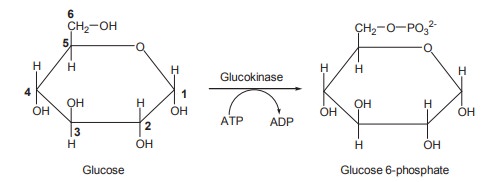
Step 2
Glucose 6-phosphate is then reversibly converted
to glucose 1-phosphate in a reaction catalysed by enzyme phosphogluco mutase.
This process requires Mg2+ and a small amount of glucose 1,6-diphosphate as
coenzyme.
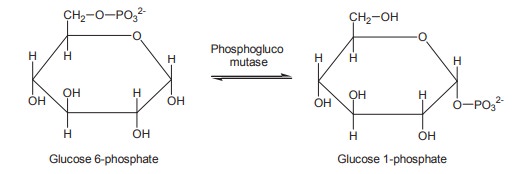
Step 3
The glucose 1-phosphate is then activated by the
energy produced by the hydrolysis of uridine triphosphate (UTP) in the presence
of uridine diphosphate glucose pyrophophosrylase. This is a key reaction in
glycogen biosynthesis.
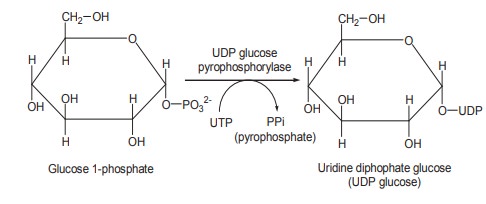
Step 4
UDP-glucose is the immediate donor of glucose
residues in the reaction catalyzed by glycogen synthase, which promotes the
transfer of the glucose residue from UDP-glucose to a nonreducing end of a
branched glycogen chain.
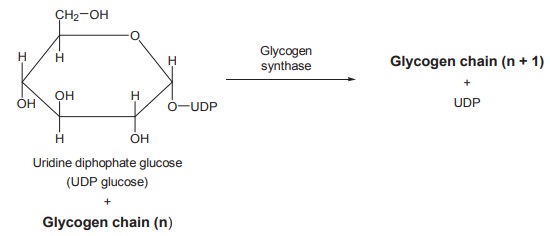
Step 5
When the chain has become long with more than 8
glucose units, a second enzyme, namely branching enzyme amylo 1-4 to 1-6
transglycosylase acts on the glycogen and helps in joining of 1,4 glycogen
chain with a similar neighbouring chain to form α 1-6 linkage, thus forming a
branching point in the molecule. Glycogen thus formed may be stored in liver,
muscles and tissues.
2. Degradation of glycogen (Glycogenolysis)
When the blood sugar level falls (Hypoglycemia),
glycogen stored in the tissues specially glycogen of liver and muscles may be
broken down and this process of breakdown of glycogen is called glycogenolysis.

The following are the various steps of glycogenolysis.
Step 1
The first step in the breakdown of glycogen is
catalyzed by two enzymes which act independently.
The first enzyme, namely glycogen phosphorylase
with inorganic phosphate catalyses the cleavage of a terminal a 1-4 bond of
glycogen to produce glycogen with one molecule less and a molecule of glucose
1-phosphate. The enzyme glycogen phosphorylase cannot cleave a 1-6 linkage.
This is carried out by another enzyme called the debranching enzyme (a 1-6
glucosidase) which hydrolyses these bonds and thus make more a 1-4 linkage
accessible to the action of glycogen phosphorylase.
The combined action of glycogen phosphorylase
and the debranching enzyme converts glycogen to glucose 1-phosphate.
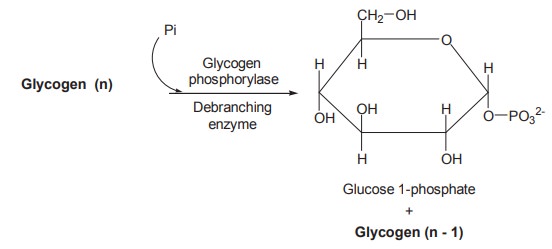
Step 2
The glucose 1-phosphate is then reversibly
converted to glucose 6-phosphate by the action of the enzyme
phosphoglucomutase.
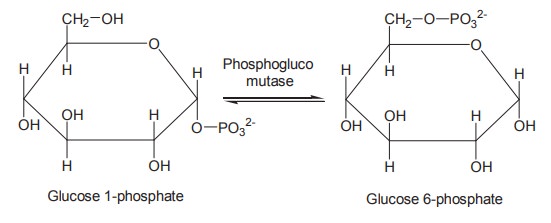
Step 3
The next reaction namely the conversion of
glucose 6-phosphate to glucose takes place in the liver and kidney by the
action of the enzyme glucose 6-phosphatase.
Glucose 6-phosphatase removes phosphate group
from glucose 6-phosphate enabling the free glucose to diffuse from the cell
into the extra cellular spaces including blood. This reaction does not occur in
the muscles because muscles lack the enzyme glucose 6-phosphatase.
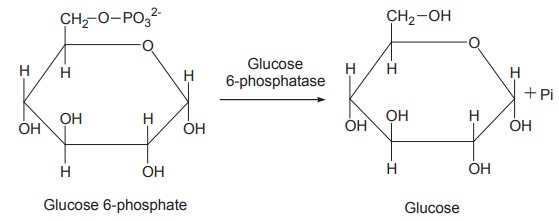
3. Gluconeogenesis
The synthesis of glucose from non-carbohydrate
precursors is known as gluconeogenesis. The major site of gluconeogenesis is
liver. It usually occurs when the carbohydrate in the diet is insufficient to
meet the demand in the body, with the intake of protein rich diet and at the
time of starvation, when tissue proteins are broken down to amino acids.
Gluconeogenesis and glycolysis
Gluconeogenesis and glycolysis are opposing
metabolic pathways and share a number of enzymes. In glycolysis, glucose is
converted to pyruvate and in gluconeogenesis pyruvate is converted to glucose.
However gluconeogenesis is not exact reversal of glycolysis.
There are three essentially irrevesible steps in
glycolysis which are

In gluconeogenesis these three reactions are
bypassed or substituted by the following news ones.
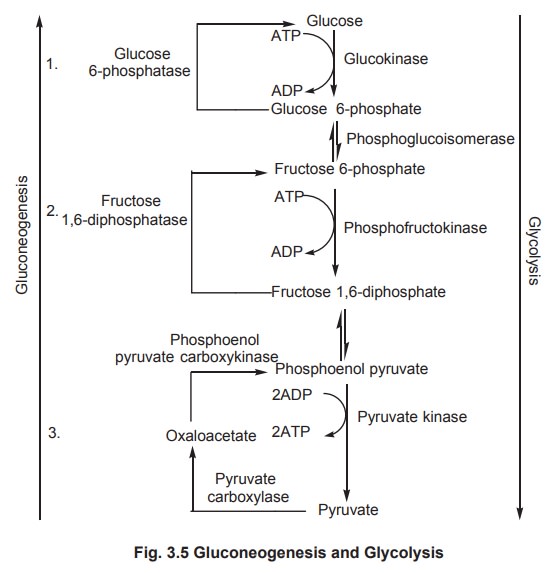
Reactions of gluconeogenesis
1. The formation of phosphoenol pyruvate begins
with the carboxylation of pyruvate at the expense of ATP to form oxalo acetate.

Oxaloacetate is converted to phosphoenolpyruvate by phosphorylation with GTP, accompanied by a simultaneous decarboxylation.

2. Fructose 6-phosphate is formed from fructose
1,6-diphosphate by hydrolysis and the enzyme fructose 1,6-diphosphatase
catalyses this reaction.

3. Glucose is formed by hydrolysis of glucose
6-phosphate catalysed by glucose 6-phosphatase.

Gluconeogenesis of amino acids
Amino acids which could be converted to glucose
are called glucogenic amino acids. Most of the glucogenic amino acids are
converted to the intermediates of citric acid cycle either by transamination or
deamination.
Gluconeogenesis of Propionate
Propionate is a major source of glucose in
ruminants, and enters the main gluconeogenic pathway via the citric acid cycle
after conversion to succinyl CoA.
Gluconeogenesis of Glycerol
At the time of starvation glycerol can also
undergo gluconeogenesis. When the triglycerides are hydrolysed in the adipose
tissue, glycerol is released. Further metabolism of glycerol does not take
place in the adipose tissue because of the lack of glycerol kinase necessary to
phosphorylate it. Instead, glycerol passes to the liver where it is
phosphorylated to glycerol 3-phosphate by the enzyme glycerol kinase.

This pathway connects the triose phosphate stage
of glycolysis, because glycerol 3-phosphate is oxidized to dihydroxy acetone
phosphate in the presence of NAD+ and glycerol 3-phosphate
dehydrogenase.

This dihydroxy acetone phosphate enters
gluconeogenesis pathway and gets converted to glucose. Liver and kidney are
able to convert glycerol to blood glucose by making use of the above enzymes.
Gluconeogenesis of lactic acid (Cori cycle)
The liver and skeletal muscles exhibit a special
metabolic cooperation as far as carbohydrates are concerned by the way of a
cycle of conversions known as Cori cycle.

In this cycle liver glycogen may be converted
into muscle glycogen and vice versa and the major raw material of this cycle is
lactate produced by the active skeletal muscles.
At the time of heavy muscular work or strenuous
exercise, O2 supply is inadequate in active muscles but the muscles
keep contracting to the maximum. Hence, glycogen stored up in the muscle is
converted into lactic acid by glycogenolysis followed by anaerobic glycolysis
and thus lactate gets accumulated in the muscle. Muscle tissue lacks the enzyme
glucose 6-phosphatase hence it is incapable of synthesizing glucose from lactic
acid and the conversion take place only in the liver.
Lactate diffuses out of the muscle and enters
the liver through blood. In the liver lactate is oxidised to pyruvate which
undergoes the process of gluconeogenesis resulting in the resynthesis of
glucose. The glycogen may be once again converted to glucose (glycogenolysis)
and may be recycled to the muscle through the blood. The process of
gluconeogenesis completes the cycle by converting glucose once again to muscle
glycogen.
Related Topics